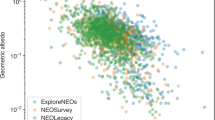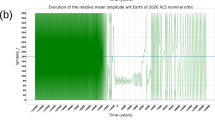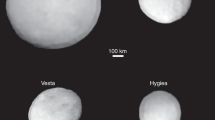Abstract
OBSERVATIONS of stellar occultations by asteroids have suggested that some may have satellites1. But given the absence of any confirmatory evidence, the prevailing view has been that although such satellites probably do exist, they are likely to be rare2. Here we report the discovery3 by the Galileo spacecraft of a satellite associated with the asteroid 243 Ida. Although the satellite, Dactyl, is only 1.6km across, it has been imaged with sufficient resolution for geological analysis. We describe the physical properties of Dactyl, with emphasis on its notably smooth shape, its crater population (which includes a crater chain) and its photometric properties. We find that, spectroscopically, Dactyl resembles both Ida and the other members of the Koronis asteroid family, implying a similar composition; small spectral differences may reflect a space weathering process that slightly alters the colours with time. We argue that Dactyl originated during the breakup of the Koronis parent body, and that satellites could be common around other asteroids (particularly members of asteroid families).
This is a preview of subscription content, access via your institution
Access options
Subscribe to this journal
Receive 51 print issues and online access
$199.00 per year
only $3.90 per issue
Buy this article
- Purchase on Springer Link
- Instant access to full article PDF
Prices may be subject to local taxes which are calculated during checkout
Similar content being viewed by others
References
Van Flandern, T. C., Tedesco, E. F. & Binzel, R. P. in Asteroids (ed. Gehrels, T.) 443–465 (Univ. Ariz. Press, Tucson, 1979).
Weidenschilling, S. J., Paolicchi, P. & Zappaià, V. in Asteroids II (eds Gehrels, T., Binzel, R. P. & Matthews, M. S.) 643–658 (Univ. Ariz. Press, Tucson, 1989).
Belton, M. J. S. & Carlson, R. IAU Circ. No. 5948 (1994).
Belton, M. J. S. et al. Science 265, 1543–1547 (1994).
Simonelli, D. P., Thomas, P. C., Carcich, B. T. & Veverka, J. Icarus 103, 49–61.
Belton, M. J. S. et al. Nature 374, 785–788 (1995).
Thomas, P. Icarus 77, 248–274 (1989).
Gaffey, M. J. et al. Icarus 106, 573–602 (1993).
Gradie, J. C., Chapman, C. R. & Williams, J. G. in Asteroids (ed. Gehrels, T.) 359–390 (Univ. Ariz. Press, Tucson, 1979).
Binzel, R. P., Xu, S. & Bus, S. J. Icarus 106, 608–611 (1993).
Dermott, S. F., Gradie, J. & Murray, C. D. Icarus 62, 289–297 (1985).
Pieters, C. M., Fischer, E. M., Rode, O. & Basu, A. J. geophys. Res. 98, 20817–20824 (1993).
Veverka, J. et al. Icarus (submitted).
Sullivan, R. et al. Icarus (submitted).
Gehrels, T., Drummond, J. & Levenson, N. Icarus 70, 257–263 (1987).
Hartmann, W. K. in Asteroids (ed. Gehrels, T.) 466–479 (Univ. Ariz. Press, Tucson, 1979).
Martelli, G. et al. Astr. Astrophys. 271, 315–318 (1993).
Durda, D. D. Bull. Am. astr. Soc. 26, 1158 (1994).
Belton, M. J. S. et al. Science 257, 1647–1652 (1992).
Binzel, R. P. Icarus 73, 303–313 (1988).
Marzari, F., Davis, D. & Vanzani, V. Icarus 113, 168–187 (1995).
Ostro, S. J. et al. Science 248, 1523–1528 (1990).
Bottke, W. F. & Melosh, H. J. Lunar planet. Sci. XXVI, 153–154 (1995).
Author information
Authors and Affiliations
Rights and permissions
About this article
Cite this article
Chapman, C., Veverka, J., Thomas, P. et al. Discovery and physical properties of Dactyl, a satellite of asteroid 243 Ida. Nature 374, 783–785 (1995). https://doi.org/10.1038/374783a0
Received:
Accepted:
Issue Date:
DOI: https://doi.org/10.1038/374783a0
This article is cited by
-
Extended two-body problem for rotating rigid bodies
Celestial Mechanics and Dynamical Astronomy (2021)
-
Small Solar System Bodies as granular media
The Astronomy and Astrophysics Review (2019)
-
Equilibrium points and associated periodic orbits in the gravity of binary asteroid systems: (66391) 1999 KW4 as an example
Celestial Mechanics and Dynamical Astronomy (2018)
-
Mutual gravitational potential, force, and torque of a homogeneous polyhedron and an extended body: an application to binary asteroids
Celestial Mechanics and Dynamical Astronomy (2017)
-
The Explored Asteroids: Science and Exploration in the Space Age
Space Science Reviews (2015)
Comments
By submitting a comment you agree to abide by our Terms and Community Guidelines. If you find something abusive or that does not comply with our terms or guidelines please flag it as inappropriate.



